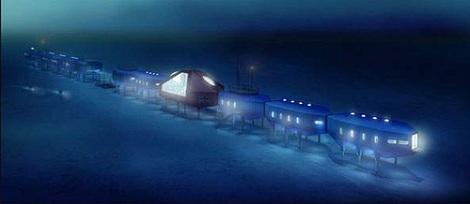DISEÑO PARA UNA BASE COLONIALISTA
Twittear Share
NUEVA ESTACION HALLEY EN LA ANTARTIDA
El estudio de arquitectos Maunsell y Broughton resulto ganador del concurso para la nueva estación Halley en la antartida en 2005, un módulo acoplable elevado en esquí que puede ser remolcado sobre el hielo próximo a inaugurar. Los módulos son fácilmente transportables y de fácil armado, adaptables a las necesidades de los programas científicos.
Los módulos cuentan con fuentes de energía renovables y novedosas estrategias ambientales en el manejo de residuos y combustibles. Sin lugar a dudas es un diseño que mejora las condiciones de vida e investigación en la Antártida. Lamentablemente, la base fue creada bajo la excusa de evitar el anclaje de naves nazis, pero es evidente que su implantación respondía a la necesidad de establecer un punto estratégico que permita reclamar por las islas Malvinas, usurpadas por la piratería británica en 1833.
La propia web del British Research Survey, describe el origen colonialista de la base: El gobierno británico estableció sus primeras estaciones en la Antártida como parte de la expedición durante la guerra conocida como la Operación Tabarin en 1944. Sus objetivos eran impedir el acceso a los anclajes de las naves enemigas y fortalecer reclamo de Gran Bretaña de las Dependencias de las Islas Falkland. Esto también proporciona una oportunidad para llevar a cabo la investigación científica. (www.antarctica.ac.uk)

English version
DESIGN FOR A BASE COLONIALIST
NEW HALLEY STATION IN ANTARCTICA
The architectural firm Maunsell and Broughton won the competition for the new Halley station in Antarctica in 2005, an elevated attachable module that can be towed ski on ice, next to open. The modules are easily transportable and easily assembled, adaptable to the needs of the scientific programs.
The modules have renewable energy sources and new environmental strategies in the management of waste and fuels. Undoubtedly it is a design that improves living conditions and research in Antarctica.
Unfortunately, the base was created under the pretext of preventing the anchor Nazis ships, but it is clear that its implementation responded to the need of establishing a strategic point that allows claim over the Falkland Islands, usurped by British piracy in 1833.
The very website of the British Research Survey, describes the origin of the base colonialist: The British Government established its first stations in the Antarctic as part of the wartime expedition known as Operation Tabarin in 1944. Its aims were to deter access to anchorages by enemy ships and to strengthen Britain’s claim to the Falkland Islands Dependencies. This also provided an opportunity to undertake scientific research. (www.antarctica.ac.uk)
[Show as slideshow]


.
Imágenes: © Faber Maunsell & Hugh Broughton Architects
.
Publicado en TECNNE ©Marcelo Gardinetti
Noviembre de 2012.
Portal de Arquitectura, Urbanismo, Arte y Diseño

